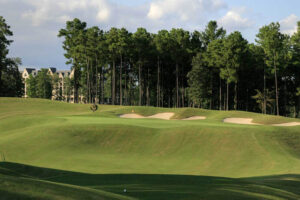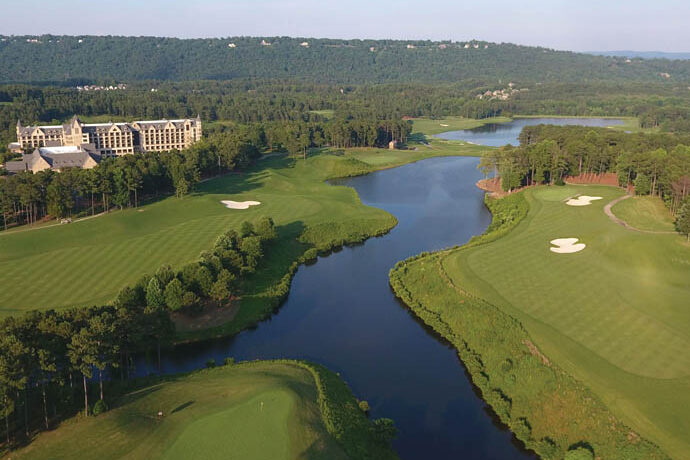Memories of 8,000 yards of abuse
It was early 2006 and a British golf magazine had caught wind of a new course in America’s Deep South that measured more than 8,000 yards. The editor, eager to know what it might be like to play one of the longest golf courses in the world dispatched me with instructions to come back with a story of multiple lost balls and a five-hour round – six, ideally. He wanted fatigue, frailty, and exhaustion. And if there was any pain involved, then so much the better.
Ross Bridge, in Hoover was the newest addition to Alabama’s famous Robert Trent Jones Trail and I was to play it from its very back tees with Chip Purser, the course’s director of golf. Purser was laughing when he said no one had been “stupid enough” to try all 18 holes from the tips yet. Not even him. It meant one of two things – first, he had a sense of humor so this might actually turn out to be a fun round, or, more likely, slogging our way over 8,000-plus yards of golf course might not turn out to be any fun at all.

Memories of our game came flooding back just a few weeks ago as I visited the course for a second time. Seventeen years had passed, but I remembered more from that day than probably 90 percent of the rounds I played this year. It obviously made quite an impression. And, yes, that British editor had got a lot of what he wanted.
Designed not by Robert Trent Jones Sr. who had passed away five years prior to its opening, Ross Bridge, like plenty of others accredited to the famed architect, was actually laid out by Jones’s long-time employee and right-hand-man, Roger Rulewich. The Yale graduate, who was more involved than Jones himself in the planning, construction, and completion of the Trail’s original 378 holes, (and many of the subsequent 72 – the Trail’s total now stands at 450), had left Jones’s firm in 1995 to set up his own and subsequently joined forces with young architect David Fleury.
Ross Bridge: The Handiwork of Roger Rulewich
Bobby Vaughan would be Rulewich’s collaborator at Ross Bridge, however. Vaughan was the man whose job it had been back in the late 1980s to identify sites for the cross-state network of courses, hire all the people necessary to build them, and manage every detail including forming the company – SunBelt Golf Corporation – that would ultimately operate the business. (Vaughan, of course, had been hired by Dr. David Bronner the CEO of the Retirement Systems of Alabama whose seemingly preposterous notion the Trail was).
The co-designers had 330 acres of rolling, mostly forested, land to play with and used it to sculpt a big-boned behemoth. The large-scale greens, water features, bunkers, and slopes were significantly grander than any I’d seen before and, to be frank, it was all a little overwhelming.

There were six sets of tees, but the publication I was working for was only interested in one of them – those set at 8,160 yards. That’s where the story was. It wasn’t cold but neither was it warm – quarter-zip weather, or rather an early 2000s polo-neck and pullover. With a little wind in our faces, the 620-yard 1st hole played like a Par 6 or 7 and, though I finished the hole with the same ball I’d started it with, it was of little consolation considering the litany of shots that had happened in between.
This wasn’t the persimmon-and- balata era, though Callaway’s Great Big Bertha II had ‘only’ reached 380cc by then. But I didn’t have one. My 260cc Titleist 975D had been a close ally for a few years, but it made hard work of Ross Bridge. The 230-yard drives (though a former teaching pro, a troublesome back was losing me five-plus yards every year) couldn’t compete with this monster’s driver-3-wood Par 4s and 5-wood/long-iron Par 3s. We weren’t that many holes into the round when I began to tire.
Smiles, joviality were replaced by grueling work
By the time we reached the turn, most, if not all, the smiles and joviality had disappeared. Chip and I were enjoying each other’s company sure enough, but I already knew this would be my first and last time. Chip was a better golfer than me, but he too was clearly struggling to see the funny side.
Still the director of golf at Ross Bridge, Purser says the course now hosts two popular events from the tips every year – a two-man scramble in the spring and a better-ball at the end of summer. “I’d say only 20 percent of the field think they can win, though,” he adds. “The rest play to say they did it.”
Doing it 17 years ago wasn’t some heroic, special-ops challenge, of course. I was just playing a bit more golf than usual. But, even in a cart, it was disagreeable… fun at times certainly, but mostly unpleasant.
Following the round, Purser and I drove into Hoover and gorged ourselves on boneless wings. Too tired to talk, we barely said a word to each other.
Purser has played the tips quite a few times since 2006 but says he hasn’t done so for a few years. At some point, he adds, it just lost its appeal. “I love Ross Bridge, but not from there. I still want to enjoy my golf,” he says.
An accident led to new greens, improvements
In September of 2022, a regrettable incident occurred when a bag of herbicide/fertilizer was mistaken for a bag of top-dressing mix and 14 of Ross Bridge’s greens suffered a slow burn from which there was no recovery, and the course shut down.
SunBelt Golf had planned on replacing the bentgrass surfaces with a new ultradwarf Bermuda in 2025, but the greens’ demise led to a reschedule that saw the work carried out earlier this year. And, as well as new turf for the greens, a number of other projects were completed. Dozens of trees came down, the tees at the Par 3 14th were rebuilt, and several bunkers were either relocated or removed. Cart paths moved closer to the fairways, the 10th green was not only returfed but also repositioned, and drainage issues were addressed.
The course reopened early in October and the quality of the work was immediately apparent. The course was in superb condition; the new greens firm, fast, and smooth. Ross Bridge was the big, brawny, beautiful course I remember from 2006. Only this time it was 1,500 yards shorter because I’d had the good sense to pick a different set of tees.
Tony Dear, a former British PGA golf apprentice before coming to the U.S., is an author and freelance golf writer. He lives in Bellingham, Washington.
Have a story idea or a news item to report to Alabama Golf News? Email gregg@alabamagolfnews.com
Featured image courtesy of the Robert Trent Jones Golf Trail.











